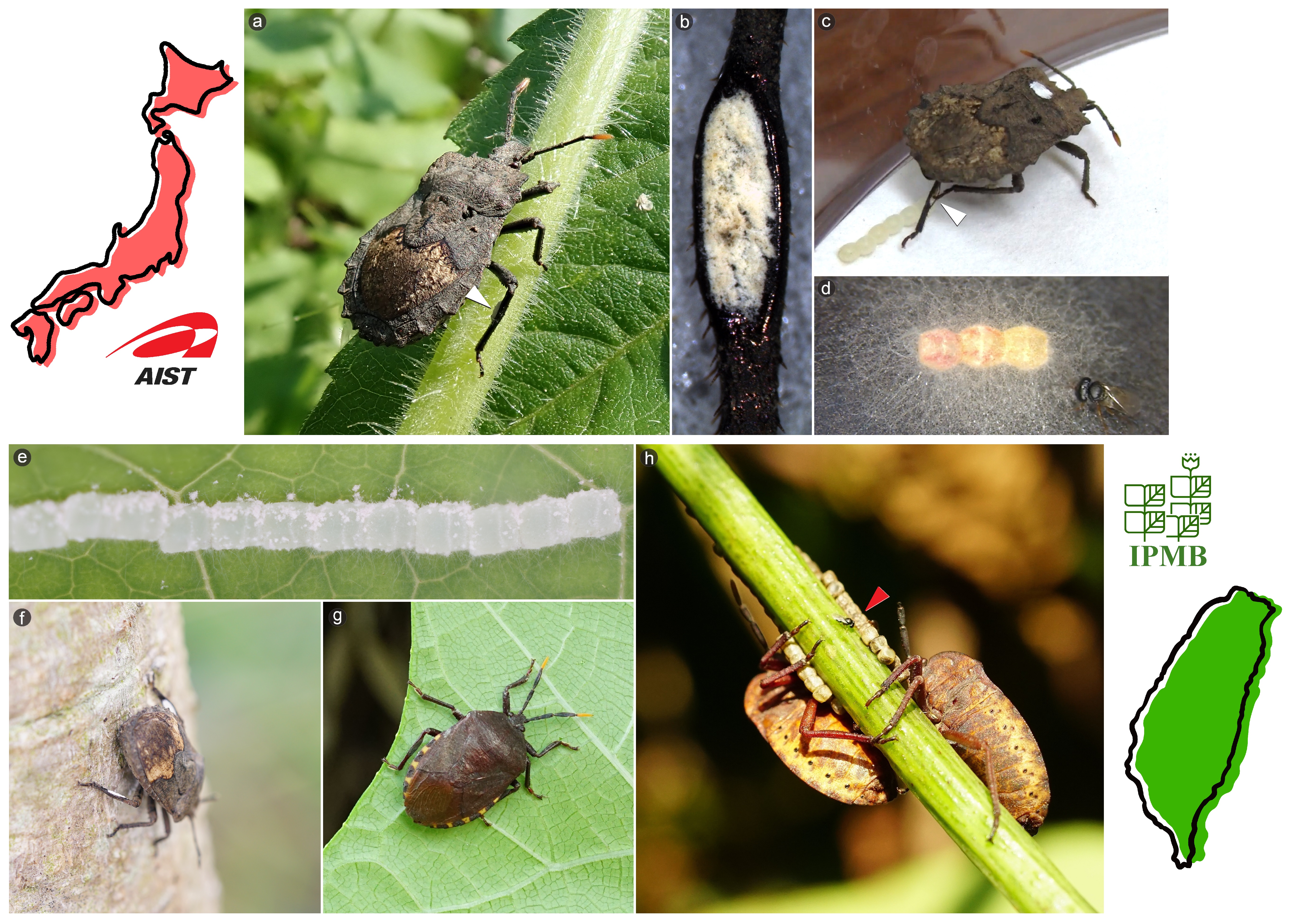[Chih-Horng Kuo] Defensive symbiosis: Stinkbugs use fungi to shield their eggs from parasitic wasps
POST:
Defensive fungal symbiosis on insect hindlegs. A novel discovery made through an international collaboration among the National Institute of Advanced Industrial Science and Technology (AIST) in Japan, the Institute of Plant and Microbial Biology (IPMB) at Academia Sinica in Taiwan, and other partners. (a) A female stinkbug Megymenum gracilicorne (Hemiptera: Dinidoridae) from Japan; the hindleg symbiotic organ is indicated by an arrowhead. (b) Whitish symbiotic fungi propagating on the surface of the hindleg organ. (c) Immediately after laying an egg, the female uses the claws of the opposite leg to touch the fungus-growing organ and smear the fungi onto the egg surface. This behavior is repeated for each newly laid egg. (d) Fungal hyphae proliferating on the egg surface, preventing access by a parasitoid wasp. (e) An egg cluster of Megymenum brevicorne from Taiwan, covered with symbiotic fungal hyphae. (f) A M. brevicorne female showing white fungi on her hindleg organs. (g) A female Coridius chinensis from Taiwan, harboring gray fungi on the hindleg organs. (h) A pair of Cyclopelta parva from Taiwan guarding their eggs. A parasitoid wasp approaching the eggs is indicated by an arrowhead.
Stinkbugs are common agricultural pests, notorious for damaging crops and difficult to control. Chemical pesticides raise environmental concerns and face the problem of resistance, while parasitic wasps are widely used as natural biocontrol agents. In a new study, an international team of researchers has discovered a remarkable strategy in which stinkbugs form a defensive alliance with fungi, using them to physically protect their eggs from wasp parasitism.
A surprising role for the “ear” on stinkbug legs
Insects are known to evolve tympanal organs, membranous structures that function like ears to detect sound. Female stinkbugs of the family Dinidoridae were previously thought to possess such organs on their hindlegs. However, close investigation of the Japanese stinkbug Megymenum gracilicorne revealed that this enlarged structure is not for hearing at all. Instead, it is a specialized organ for housing and cultivating fungi.
The organ consists of thousands of tiny pores connected to secretory cells. In reproductive females, these pores are filled with fungal hyphae that grow outward, creating a white, fibrous covering on the hindlegs. When laying eggs, females scrape and smear the fungi onto the egg surface. Within days, the fungi spread to cover the entire egg mass.
Fungal bodyguards
Laboratory and field experiments confirmed that the fungi provide highly effective protection against parasitic wasps. Eggs without fungal covering were readily parasitized, while fungus-covered eggs were largely protected. The fungi do not attack the wasps chemically but instead act as a physical barrier, preventing the wasps from piercing the egg surface.
The fungal partners belong mainly to the Cordycipitaceae, a group that includes many insect pathogens. Yet the species carried by the stinkbugs are relatively harmless to their hosts, suggesting that the insects selectively cultivate benign strains. This discovery expands the concept of insect–microbe symbiosis, showing that microbes can also serve as external, structural protectors.
An ancient and widespread strategy
Following detailed studies of M. gracilicorne in Japan, the researchers examined other dinidorid species, including Eumenotes pacao from Okinawa, and Megymenum brevicorne, Coridius chinensis and Cyclopelta parva from Taiwan. All were found to have the same hindleg organ and the distinctive egg-smearing behavior. These findings suggest that the defensive fungal symbiosis evolved early in the Dinidoridae lineage and has been maintained across multiple species.
International collaboration
The study was led by Dr. Takema Fukatsu, Prime Senior Researcher at the National Institute of Advanced Industrial Science and Technology (AIST) in Japan, with Dr. Chih-Horng Kuo, Research Fellow at Academia Sinica in Taiwan, leading the investigation of Taiwanese stinkbugs. This work was supported by the Japan Society for the Promotion of Science (JSPS), the Japan Science and Technology Agency (JST), and Academia Sinica.
The collaboration integrated long-standing Japanese expertise in insect–microbe symbiosis with Taiwanese strengths in biodiversity and evolutionary research. Through close cooperation, the teams revealed that this defensive symbiosis represents an ancient and widespread strategy among stinkbugs.
The success of this project also reflects the strong and long-standing relationship between Dr. Fukatsu and Dr. Kuo, whose shared interest in symbiosis fostered an effective partnership. The collaboration was also strengthened by co-first author Dr. Masahiko Tanahashi, who moved from Japan to Taiwan and joined Dr. Kuo’s team, contributing to the success of this project.
Publication Information
Takanori Nishino, Minoru Moriyama, Hiromi Mukai, Masahiko Tanahashi, Takahiro Hosokawa, Hsin-Yi Chang, Shuji Tachikawa, Naruo Nikoh, Ryuichi Koga, Chih-Horng Kuo, Takema Fukatsu. Defensive fungal symbiosis on insect hindlegs. Science 390, 279-283 (2025). https://www.science.org/doi/full/10.1126/science.adp6699